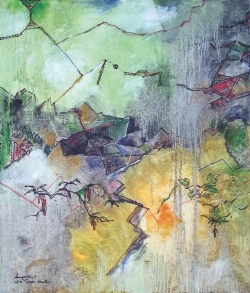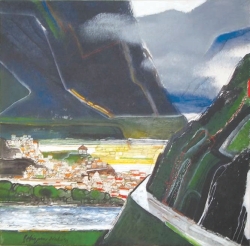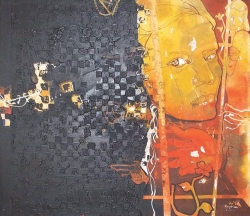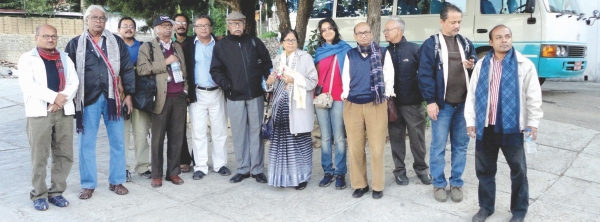| Home - Back Issues - The Team - Contact Us |
 |
| Volume 10 |Issue 42 | November 04, 2011 | |
|
|
Reflections Art Camping in Paradise Sylvia Nazneen
Noted artists of Bangladesh recently went to the Himalayan kingdom of Bhutan to participate in a unique art camp. They spread their canvasses on the lap of the majestic Himalayas and unleashed a riot of vibrant colours onto their palates. The colourful nature of beautiful Bhutan, the hide and seek game of clouds atop hills on the horizon came alive on the canvass of the artists. Artists Qayyum Chowdhury, Rafiqun Nabi, Samarjit Roy Chowdhury, Tahera Khanam, Mansur-Ul-Karim, Ranjit Das, Mahmudul Haque, Hamiduzzaman Khan, Tarun Ghosh, Shishir Bhattarcharjee and Nagorabshi Barman, took part in this magnificent experience, hosted by Gautam Chakraborty, owner of the popular art gallery, Kaya. The artists reached Bhutan on September 23, at noon and were greeted by a blast of cold weather. They took some time to adjust to the lower temperatures common to places located near the mountains. It was like a brutal December in Bangladesh. After reaching Bhutan, the artists were in for an unpleasant surprise--their baggage, including painting supplies, never left the luggage belts of Dhaka! However, the next group, were kind enough to bring the left over luggage with them along with the smiles that had once again resurfaced on every face. After reaching the Daughter of the Himalayas- as Bhutan is popularly known as-the artists made sketches and enjoyed the natural beauty of their surroundings. When they reached the Thimpu resort, all the artists had lunch and got down to business- painting. The nature had started changing its colours. The clouds in the sky hinted at impending rain. The rhythmic song of the rainfall soon followed. Evening slowly descended with the rain on Thimpu, through the forests of pine, oak and apple trees. Nightfall in Bhutan was even more serenely wonderful. Walking down the hills from the resort to the town, houses built at different levels of the hilly area looked like lighthouses from a dream. There were very few motor vehicles, and therefore very little noise to disturb the peaceful silence. We felt like aliens in an unreal, yet beautiful new world. When we came down from the hills, we realised the town below did not look like a town at all. There were very few shops and motor vehicles and life seemed to be very slow paced. There were no streetlights like we are accustomed to in Dhaka, and we ended up returning to the resort on foot. The artists had already started preparing their canvasses in dim lights of their rooms. Rounds of tea and coffee were adding fuel to their lively conversation, when the dinner bell was rung. The people of Bhutan are very hospitable and the dinner they prepared for us was proof of that. The menu included rice, vegetables, lentil soup, chicken, pork, beet and papad. The amount of spice in the curries was much more than we use in Dhaka, but the food was delicious. The Bhutanese seem to have a fascination for red pepper. Large red peppers were always peeping out from the windows of houses and roofs of vehicles. The next day began with a glorious sunrise. The sunrise in hilly areas is a little different, a little more special. The light first reflects from the highest peak of the mountains and then spreads all over the surroundings below. After witnessing this stunning scene, we were inspired to go sight seeing. We began our tour with the National Memorial Pagoda at the city centre. Thimpu boasts of a big bronze statue known as “Buddha Shakyamuni” or Buddha Point situated on the top of a hill and can be seen from all around. It is possibly the biggest sculpture in the world and bears a striking resemblance to Christ the Redeemer in Brazil.
Surprisingly, there is no large institution that teaches art in Bhutan. However, a national institute with different departments like painting, wood engraving, embroidery and sculpture are catering to students who aspire to study art. To Bhutanese people, presenting their history and heritage to the world through art is more important than modern techniques and themes. There is an art gallery in Bhutan, which is the centre for different artistic and cultural activities. Painter Qayyum Chowdhury says, in such camps, artists get the opportunity to exchange their views and experiences, which enriches them and opens up new horizons for them. According to Rafiqun Nabi, a new environment affects the works of the artists in different ways. He says the customs, culture etc will have an influence on the artists who participated in the camp. Gautam Chakravarty, who organised the event says, the different landscape adds new dimension to the viewpoint of the artists. Shishir Bhattacharjee shares that he was charmed by the simple life style of Bhutanese people. He says the Bhutanese people are impeccably well behaved, they are honest, and have a sense of balance and maturity. He likes the fact that their religion has an important influence on their lives. Every artist painted on three canvasses, remaining true to their own style. The paintings depicted nature, landscape and some were abstract paintings. The weeklong art camp was truly successful, and the artists claimed to have added much to their knowledge and techniques through this thoroughly enriching experience.
Copyright
(R) thedailystar.net 2011 |



